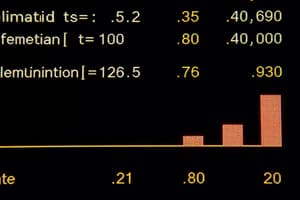Podcast
Questions and Answers
What is the primary purpose of inferential statistics?
What is the primary purpose of inferential statistics?
- To summarize data using measures of central tendency
- To draw conclusions about a larger population based on sample data (correct)
- To visualize data through graphs and charts
- To describe data patterns
When is inferential statistics particularly useful?
When is inferential statistics particularly useful?
- When creating visual representations of data
- When analyzing a small dataset with few variables
- When making conclusive statements about a specific sample
- When conducting research on a large scale or with limited data points (correct)
What is a key benefit of using inferential statistics in research?
What is a key benefit of using inferential statistics in research?
- Ensuring every member of the population is surveyed
- Obtaining precise measurements for the entire population
- Creating an accurate visual representation of the data
- Making educated guesses about the entire population based on a sample (correct)
Which type of test does not require a normality assumption for its application?
Which type of test does not require a normality assumption for its application?
What measures of central tendency are commonly used in parametric tests?
What measures of central tendency are commonly used in parametric tests?
Why are parametric tests sensitive to the shape of the data distribution?
Why are parametric tests sensitive to the shape of the data distribution?
What is the benefit of using non-parametric tests like the Mann-Whitney U test and Kruskal-Wallis test?
What is the benefit of using non-parametric tests like the Mann-Whitney U test and Kruskal-Wallis test?
What role does the null hypothesis play in hypothesis testing?
What role does the null hypothesis play in hypothesis testing?
How do researchers determine if there is enough evidence to reject the null hypothesis?
How do researchers determine if there is enough evidence to reject the null hypothesis?
Why is inferential statistics considered a powerful tool for researchers?
Why is inferential statistics considered a powerful tool for researchers?
In the pregnancy study example provided, what was smoking associated with?
In the pregnancy study example provided, what was smoking associated with?
How does inferential statistics help researchers address biases in naturally occurring data?
How does inferential statistics help researchers address biases in naturally occurring data?
Flashcards are hidden until you start studying
Study Notes
Discovering Patterns with Inferential Statistics
Inferential statistics is a vital branch of statistics that allows us to draw conclusions about the larger population, based on data gathered from a carefully selected sample. This data analysis method is indispensable when conducting research on a large scale or when working with a limited number of data points.
The Role of Inferential Statistics
Inferential statistics help us make inferences about a population based on a random sample taken from that population. This is valuable when it is not possible to examine each member of an entire population. For instance, imagine trying to determine the average GPA of all college students in the United States. It would be impossible to gather data on all students, so we would instead gather a random sample, analyze the data, and use our findings to make an educated guess about the average GPA of all students.
Parametric and Non-Parametric Tests
Inferential statistics relies on various types of tests to draw conclusions about the data. Parametric tests are based on a normality assumption, while non-parametric tests are more flexible and do not require such stringent assumptions about the data distribution.
Parametric tests include the t-test, ANOVA, and linear regression, to name a few. These tests make use of measures of central tendency, such as the mean, and are sensitive to the shape of the data distribution.
Non-parametric tests, on the other hand, include the Mann-Whitney U test, Kruskal-Wallis test, and Spearman's rho. These tests do not require assumptions about the data distribution and are, therefore, more robust when working with data that does not adhere to a normal distribution.
The Importance of Hypothesis Testing
Hypothesis testing is a core component of inferential statistics. Through hypothesis testing, we establish a null hypothesis (H0) and an alternative hypothesis (H1). The null hypothesis states that there is no difference between the data and the population or that a particular relationship does not exist. The alternative hypothesis proposes the opposite.
We then use statistical tests to see if there is enough evidence to reject the null hypothesis. If the data is strong enough to reject the null hypothesis, we can conclude that there is a difference or a relationship in the data.
Examples of Inferential Statistics
Inferential statistics are used in a multitude of fields to help researchers draw conclusions about their data. For example, in a study of 5,659 pregnancies, a researcher divided the group into smokers and non-smokers, recording the outcome of each pregnancy over a six-year period. Smoking was associated with an increased incidence of premature babies, but not with infant mortality.
In another example, to disentangle truth from bias in naturally occurring data, a technique that leverages duplicate records in crowdsourcing data could potentially help mitigate the effects of biases in research.
Inferential statistics is a powerful tool that allows researchers to generalize from a sample to a larger population. As a researcher, it is essential to understand the fundamentals of inferential statistics, the role of hypothesis testing, and the various statistical tests used to draw meaningful conclusions.
Studying That Suits You
Use AI to generate personalized quizzes and flashcards to suit your learning preferences.



